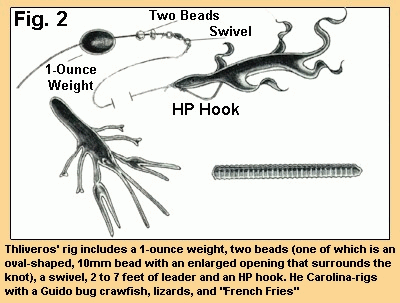 |
|
Written And Illustrated By BERNIE SCHULTZ
Dragging a lizard on a Carolina rig is one of this young Florida pro's fortes...
When fast-paced tactics fail to produce, a Carolina rig may be your best -
or only - bet to stir up some action.
|
Despite what many anglers believe, Carolina rigs can be fished quickly,
without compromising efficiency. Considered to be a super-slow pattern,
the truth is, they're the quickest way, aside from crankbaits, to search out
the bottom features of any likely area.
|
For instance, if bass are holding on secondary points in 5 to 10 feet of water around
stumps, chances are good that other points (with similar cover at the same depth) will also
hold fish. Thus, the basics of a point pattern. Then it's only a matter of determining
the best soft plastic for the job.
|
|
|

|
|||
His basic rig consists of lead weight, approximately 1-ounce in weight, two beads,
a swivel and either a Luck "E" Strike HP hook or a typical offset worm hook (See Fig. 2.)
|
During pre- and post-spawn periods, Thliveros works spawning flats adjacent to
points. He often targets the shallower parts of the point itself as he looks for
staging females. Tips For Carolina Rigging Thliveros suggests staying in close contact with the bottom by reading signals transmitted from the lead weight through a graphite rod. When you feel the lead strike an object, pause it while shaking the rod tip to rattle the beads. If this fails to produce a strike, lift the rod to pull the soft plastic bait onto the cover. Shake the rod tip on a slack line while the bait hovers over the object. Usually, this is all that is needed to excite the fish into striking. |
|||
![]() Send e-mail to bernie@bernieschultzfishing.com with questions or comments about this web
site.
Send e-mail to bernie@bernieschultzfishing.com with questions or comments about this web
site.

